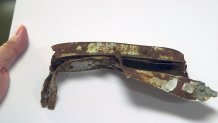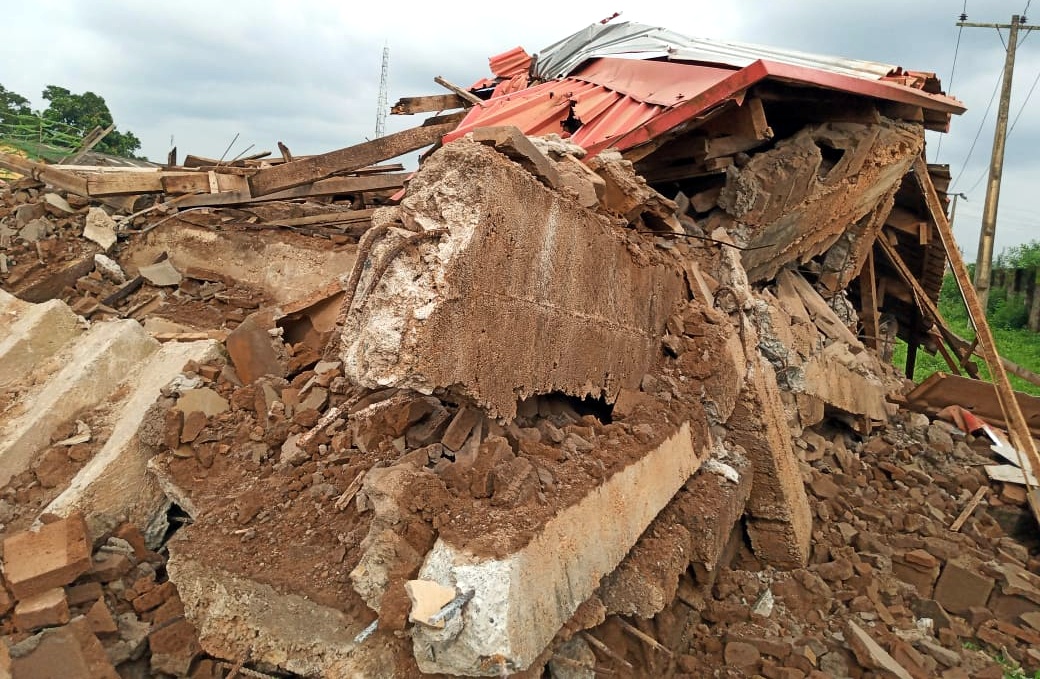USS Hornet Museum lands piece of historic Doolittle Raid - NBC Bay Area
Some eight decades after 16 bombers left the U.S. for a brazen bombing raid on Tokyo following the attack on Pearl Harbor, a small piece of wreckage from the squadron that became known as the Doolittle Raiders has come home to the Bay Area.
In a unique cultural exchange, The Doolittle Raid Memorial Hall in Quzhou City traded the eight-inch piece of steel ripped from a B-25 bomber named the Whirling Dervish to the USS Hornet Museum in Alameda for an original reel of 16mm film showing the Raiders training for their historic mission.
“This is shared sacrifice right here,” said George Retelas, a volunteer with the USS Hornet, holding the piece of twisted metal. “This is two countries fighting together for freedom.”
Retelas, who proposed the exchange and then traveled to China to deliver the film and collect the artifact, pointed out the serial number inscribed on the 8-inch piece of metal that began with 62B, the designation for a B-25 Mitchell bomber. The crew of the Whirling Dervish all survived the crash landing in China and were hidden and protected by families near Quzhou City.
“When they handed it to me, I see a symbol of the United States and China in this one image," Retelas said.
The Doolittle Raiders, named for their commander Jimmy Doolittle, trained for their mission at Eglin Field in Florida and then launched on Tokyo from the first USS Hornet CV-8 aircraft carrier. The Doolittle Raid was extremely risky because the bombers could only carry enough fuel to drop their bombs on Tokyo and, with a prayer, make it to safety in allied China.
Just before the daring mission, Retelas’ grandfather was serving as a Navy mechanic at the Alameda Naval Air Station when one night he was rousted out of bed and ordered to help load 500 bombs onto a mysterious aircraft carrier loaded with U.S. Army planes. He later learned the ship was the original USS Hornet and the bombers were the Doolittle squadron destined for Tokyo.
“And they put it together and they couldn’t believe it,” Retelas said.

Joe Rosato Jr./NBC Bay Area
A piece of the fuselage of the B-25 bomber Whirling Dervish that crashed into China following the bombing of Tokyo in 1942 as part of the Doolittle Raid. The piece will now go on display at the USS Hornet Museum in Alameda.
Retelas, who works in marketing at Menlo College, was inspired by his grandfather’s military journals and began volunteering at the USS Hornet CV-12 museum in Alameda. The aircraft carrier-turned-museum was named for the original USS Hornet that carried out the Doolittle mission and sunk in battle seven months later.
In a bit of irony, Retelas was helping sift through boxes of ephemera in the Hornet museum’s archive room when he discovered a reel of 16mm film with "Doolittle" handwritten on the metal canister that had been donated. Through a grant, the Hornet volunteers got the film digitized.
“It was the Doolittle Raiders training in 1942 before they shipped off for the Hornet for their Tokyo raid,” Retelas said. “What you see in this footage is the preparations and personalities of all the Raiders before they flew. And they’re smiling knowing this is a one-way mission.”
In the jittery black-and-white film, the Raiders can be seen gathering together in conversation, working on the rows of 16 bombers sitting on the tarmac — a pilot smiles and waves out of the window of his plane. The Hornet Museum put the footage on its YouTube channel, but Retelas said it got scant views.
In April, The Carter Center invited the Hornet staff to travel to The Doolittle Raid Memorial Hall in Quzhou City for a reunion. When Retelas saw the invitation, he jumped at the chance to go but also proposed a deal to the hosts: what if the Hornet traded its original Doolittle film and canister in exchange for a piece of the wreckage of one of the Doolittle planes?
“They got back to me, and they were like, ’We agree to your trade,'” Retelas said.
Retelas turned the trip into a cultural recon mission. During his time in Quzhou City, he met and interviewed several Chinese men who were children when their families sheltered the crews of the Doolittle Raid. One man still clutched a 1937 penny given to him by one of the crewmen.
Immediately after dropping their bombs on Tokyo, most of the pilots were forced to abandon their bombers over China’s Jiangxi, Zhejiang, Anhui and Fujian Provinces. The Chinese military, along with civilians, conducted a rescue mission and successfully evacuated 64 pilots, 50 of them taken in by families in Quzhou. In retaliation, Japan launched a massive attack on the region which claimed 250,000 Chinese lives.
“They recognize the Americans' role in helping liberate them from Japan,” Retelas said. “But then also recognize all their ancestors that were killed for doing so.”
At a ceremony in Quzhou, Retelas and the director of the memorial swapped artifacts, and Retelas flew back to the Bay Area clutching the bit of metal that will go into a new Doolittle Raid exhibit aboard the USS Hornet. Retelas identified the piece as coming from the Whirling Dervish’s fuselage.
“This will be the only known fragment of a Doolittle Raider aircraft that will be on public display,” Retelas crowed, wearing a retro leather jacket with patches signifying both the USS Hornet and the Doolittle mission.
Retelas sees the piece of bomber wreckage as a symbol of the American-China relations in the face of a common enemy. He hopes putting the artifact on public view will inspire a younger generation to dig deeper into the Doolittle Raid story and its many lessons about sacrifice and bravery.
“I just find myself wanting to be back here to help volunteer,” Retelas said, standing on the dock in the shadow of the massive aircraft carrier. "To help tell the story for the next generation of kids out there that never got to meet the greatest generation.”











